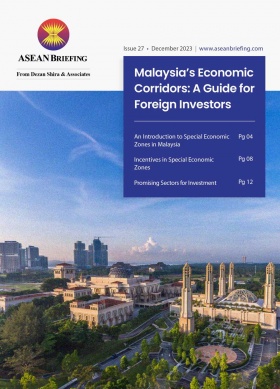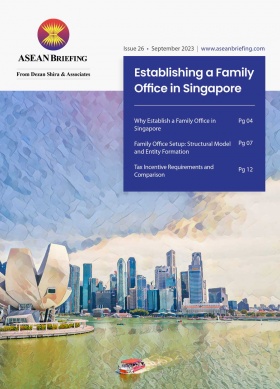Singapore Economy Recap for 2023
We recap key economic indicators from Singapore in 2023, including trends and opportunities that secure a unique spot for the city-state on the global stage.
Singapore’s economic journey in 2023 has been characterized by a nuanced interplay of global dynamics and local resilience. Against the backdrop of softer global demand, the city-state charted a course that saw a shift from the robust 3.6 percent GDP growth registered in 2022 to a more contained 1 percent forecast for 2023, with a cautiously optimistic outlook of 2.3 percent growth estimated for the coming year.
The ripple effects of the post-COVID-19 recovery were palpable, as Singapore’s visitor numbers gradually rebounded, surpassing one million passenger arrivals per month.
Inflation, both headline, and core, displayed a downtrend, standing at 4.1 percent and 3.0 percent respectively in Q3 of 2023. This figure reflects a broader slowdown in various goods and services categories, coupled with a stabilizing labor market.
In the realm of fiscal policy, Singapore remained steadfast in its commitment to alleviating cost-of-living pressures for households and providing crucial support for businesses. The introduction of the Enterprise Innovation Scheme, offering businesses tax deductions of up to 400 percent on qualifying, serves as a viable example of such dedication. On the other hand, there is cautious optimism for a potential loosening of monetary policy in 2024, contingent upon the continued easing of inflationary pressures.Singapore’s economic rebound in 2023: key trends
In the third quarter of 2023, Singapore’s GDP showcased positive signs of recovery, recording a 1.1 percent year-on-year growth—a notable increase from the previous quarter’s 0.5 percent, although still falling short of 2022’s growth margin.
The manufacturing sector, in particular, registered a positive trend posting a 0.5 percent quarter-on-quarter growth, thus reversing the contraction observed earlier in the year. However, the sector still faced a significant 4.6 percent year-on-year contraction.
The construction industry remained a positive outlier, achieving a noteworthy 6.3 percent year-on-year growth in the third quarter of 2023. Meanwhile, the service sector scored a 2.3 percent increase from the previous year. Both the removal of all COVID-19 restrictions in April 2022 and a resurgence in tourism contributed to a robust 12.9 percent yearly growth in the segment.
International tourism, in particular, played a pivotal role in Singapore’s economic resurgence, with a dramatic 171 percent year-on-year increase in total international visitor arrivals for the first nine months of 2023 alone.
This surge was driven by strong tourism inflows from various APAC nations, including Indonesia, Malaysia, India, and Australia, and a notable increase in visitors from China.
Consumer behavior and retail trends
The third quarter of 2023 marked a significant resurgence in Singapore’s retail landscape, witnessing approximately 3.9 million visitor arrivals—an impressive surge of 72.5 percent year-on-year and 14.5 percent quarter-on-quarter. This boost is attributed to well-attended public events like the National Day Parade, the Formula One Singapore Grand Prix night race, the Singapore River Festival in September, and the anticipation of year-end holiday festivities.
Online retail sales maintained stability, constituting 14.2 percent of total sales in both months of June and July. As a key component of online retailing strategies, live streaming and live shopping are gaining prominence as preferred avenues for both shopping and research. Major social media platforms such as TikTok, Facebook, and Instagram are capitalizing on this trend by streamlining the online shopping experience, making product browsing to checkout seamless.
Investment landscape
In the third quarter of 2023, Singapore witnessed a substantial surge in investments, reaching an impressive US$7 billion. This marked a remarkable 84.5 percent increase quarter-over-quarter and an 8.5 percent rise year-over-year
A significant contributor to this surge was the Government Land Sales (GLS) segment, constituting a substantial 59.2 percent of the total volume and amounting to US$4.1 billion.
Beyond GLS transactions, the investment landscape showcased robust performance across various sectors, with Mixed-use leading at 31.8 percent, followed by Hospitality at 18.4 percent, and Commercial at 15.5 percent
The trade surplus is in good shape
As of October 2023, Singapore’s trade balance boasted a surplus of US$4.8 billion USD, a significant increase from the previous month’s US$3.8 billion. Dating back to 1976, this consistent surplus trend, averaging US$405.1 million, is a testament to Singapore’s historical economic stability.
This economic resilience stands tall, even in the face of a decline in domestic demand (-5.6 percent YoY in the second quarter of 2023) and a slowdown in imports, particularly in goods (-12 percent for the year ending September 2023).
Singapore’s global hub outlook
Singapore’s journey to becoming a regional and international hub has hit remarkable milestones, particularly as a global financial center. Since March 2022, the city-state has climbed from the 6th to the 3rd position on the Global Financial Centres Index, overtaking both Hong Kong and Shanghai and trailing behind only London and New York.
A key driver of this progress has been the strategic revamping of industry transformation plans. In February 2023, Singapore unveiled an updated Industry Transformation Map (ITM) for the Professional Services Industry. This initiative aims to boost Singapore’s status as a top business hub, focusing on attracting company headquarters and enhancing professional services capabilities through digitalization and skill development. The goal is to achieve S$27 billion (US$20.24 billion) in sector value-added growth by 2025, creating an additional 3,800 jobs annually. Complementing this, the refreshed Financial Services ITM sets targets for growth and job creation through 2025.Strategic investments in long-term infrastructure projects further highlight Singapore’s commitment to hub development. The operational Tuas Port, with ongoing expansions, and the upcoming fifth terminal at Changi Airport are key components of this strategy.
Looking ahead to 2024, Singapore anticipates accelerated growth. This aligns with expectations of a rebound in global demand, especially in the tech and electronics sector. Additionally, the prospect of easing inflation opens the door for potential monetary policy adjustments in 2024, providing relief for the financial sector.
All in all, the city-state’s economy not only showcases stability but also presents diverse opportunities for investors across multiple sectors.
Yet, it remains crucial to also acknowledge potential risks. External growth slowdown, inflationary pressures, and potential spillover effects from China’s economic changes are key challenges to watch.
About Us
ASEAN Briefing is produced by Dezan Shira & Associates. The firm assists foreign investors throughout Asia and maintains offices throughout ASEAN, including in Singapore, Hanoi, Ho Chi Minh City, and Da Nang in Vietnam, in addition to Jakarta, in Indonesia. We also have partner firms in Malaysia, the Philippines, and Thailand as well as our practices in China and India. Please contact us at asean@dezshira.com or visit our website at www.dezshira.com.







